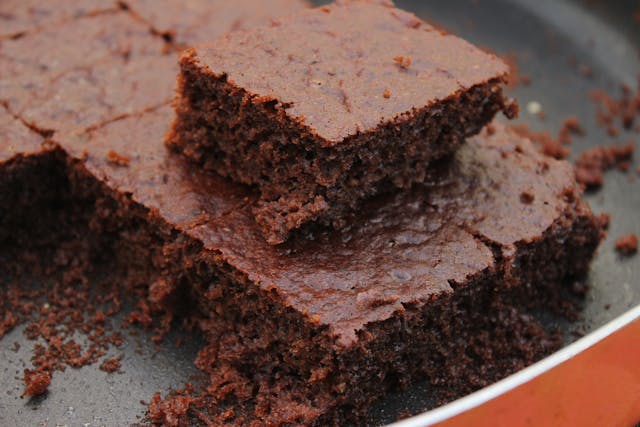Is Charlotte Doyle brownies good at cooking, evidence, recipe reality check, science, and how to actually get perfect brownies.
I started this looking for a person; a baker named Charlotte Doyle who supposedly made the “best brownies.” What I found instead was a tangle: fiction, SEO articles that re-use the name, and a recipe blueprint that looks like it borrows proven brownie technique. Here’s the cleaned, evidence-checked story, and the revised, reliable guidance you can actually use in the kitchen, similar to how collectors seek authentic vintage publications rather than reproductions.
What You'll Discover:
Who is (or isn’t) Charlotte Doyle?
Short answer: not a celebrity chef.
If you search for Charlotte Doyle you’ll quickly find her as the heroine of a 1990 historical novel aimed at middle-grade readers. That Charlotte Doyle is fictional and not a pastry pro.
At the same time, the phrase “Charlotte Doyle brownies” is currently floating around niche recipe blogs and SEO sites. Those pages present a brownie template under that name, but they don’t trace the recipe to a verifiable, single human author or cookbook lineage. In other words: the name may be a tag, a label, or a piece of internet branding; not a mark of a trained or famous baker.
So when someone asks “Is Charlotte Doyle brownies good at cooking?” we have to split the question into two things:
- Is there a professional baker Charlotte Doyle behind a canonical recipe? (No evidence found.)
- Is the recipe that travels under that label a legitimately good brownie formula? (Possibly; and that’s what we can evaluate objectively.)
What “good” means for a brownie; and what experts say
Before judging any recipe we need to agree on criteria. That’s not philosophical; it’s practical:
- Texture balance: a fudgy center, chewy edges, and a thin crackly or glossy top.
- Chocolate depth: rich, layered chocolate flavor (not simply sweet).
- Repeatability: the recipe should reliably produce similar results if you follow it.
- Ingredient logic: nothing arcane or contradictory; the proportions and technique must make culinary sense.
These are not arbitrary; professional bakers describe the modern ideal similarly: a rich chocolate flavor, crackly paper-thin crust, and a fudgy (not dry) interior.
What the web actually shows about the Charlotte Doyle brownie blueprint
I examined the small blogs and recipe re-posts that use the name. The recurring blueprint looks like this: butter, sugar, eggs, some melted chocolate or cocoa powder, modest flour, salt, optional espresso powder, and careful folding to avoid developing gluten. That mix; nothing exotic; is the classic, sensible starting point for an excellent homemade brownie. Several pages copy nearly identical ingredient lists and methods; that pattern suggests the phrase is a label attached to a tried-and-true home-baker blueprint rather than a named chef’s original innovation.
Caveat: these small sites don’t show lab tests, blind taste panels, or kitchen trials under controlled conditions. They are largely opinion + recipe posts. That means praise on them is anecdotal, not a scientific verdict.
Brownie science; what actually makes a shiny top and fudgy center
This is where good recipes become great: understanding why an ingredient or step matters.
Shiny, crackly top
That fragile, glossy top forms when sugar dissolves into the batter and the eggs create a thin meringue-like film at the surface. When that film dries and cracks as the brownie bakes, you get that glossy, paper-thin crust.
Fudgy vs cakey
The fudgy texture depends on the ratio of fat and chocolate to flour and leavening. More fat + chocolate, less flour and no (or minimal) leavening → fudgier brownies. More eggs and flour → cake-like brownies. The relative proportions; and the mechanical action (don’t overmix once flour’s added); are what determine whether you land fudgy or cakey.
Why espresso powder shows up
A small amount of instant espresso powder or brewed coffee doesn’t make brownies taste like coffee; it intensifies chocolate flavor by emphasizing the bitter chocolate notes and adding depth. This is a widely used professional trick.
Fact-checked comparison: the Charlotte Doyle blueprint vs reputable recipes
I compared the common Charlotte Doyle ingredient and method pattern against high-quality, tested recipes from trusted baking sources. Here’s what lines up and what doesn’t:
- Ingredients: both the Charlotte Doyle versions and major recipes use butter, chocolate or cocoa, sugar, eggs, flour, and salt.
- Technique: the reliable path to a glossy top in tested recipes is melting butter + chocolate (or heating butter with sugar), beating eggs + sugar until glossy, then gently folding in dry ingredients. That matches the common Charlotte Doyle descriptions; so the method is sound.
- Timing & pan variables: the recipe text floating around under Charlotte Doyle sometimes omits explicit pan-size adjustments or oven caveats. Major recipe testers always specify pan dimension adjustments because thickness changes bake times and texture. The absence of those fine details is why some people get uneven results when they copy small-blog recipes verbatim.
Conclusion: the formula itself is plausible and consistent with tested brownie science, but the faintness of provenance (no primary source, no lab testing) and the occasional missing oven/pan detail are why you’ll see both raves and flops from people who try it.
Practical, evidence-backed tips to nail the recipe
Here’s a short checklist you can use whenever you try a Charlotte Doyle type brownie:
- Preheat properly; give your oven 15–20 minutes to stabilize; use a thermometer if possible.
- Mix melted chocolate + cocoa; cocoa brings intensity, melted chocolate adds body and shine.
- Beat eggs + sugar long enough; this helps form the shiny, crackly top.
- Add a pinch of instant espresso powder; it deepens the chocolate flavor without turning the brownies into mocha.
- Mind your pan; an 8×8 vs 9×9 pan changes thickness and bake time. Adjust accordingly.
- Insulate the pan sides; if your oven runs hot at the edges, wrap foil or cake strips around the pan for more even baking.
- Cool before cutting; at least 30 minutes; or use a hot knife if you must cut early.
- Optional experimental tweak; try a double-bake method (short bake, rest, then finish) for a crusty top and fudgy interior.
Why people praise the recipe; and why some fail
Here’s the contradiction: the formula attributed to Charlotte Doyle resembles well-tested brownie technique; so praise is unsurprising. But many blog copies omit calibration details (pan size, oven calibration, or whether they used melted chocolate vs only cocoa), so novices who slavishly copy may bake at the wrong temperature or time; and get underbaked centers or scorched edges.
That doesn’t make it a hoax. It makes it a memetic container for a solid home-baker approach.
Evidence-based verdict
- Is there a famous baker named Charlotte Doyle behind a canonical brownie? No. The name is used on small recipe blogs and is also a fictional character from literature.
- Is the recipe traveling under that name consistent with tested brownie science and good technique? Yes. The ingredient ratios and method match what professionals recommend.
- Will it perform well for an attentive home baker? Very likely, provided you respect oven temps, pan sizes, and the cooling step.
So, in plainer terms: the phrase is a label more than an author. The recipe itself looks solid if you follow real test-kitchen rules. The hype around the name is real, but the provenance is weak.
A reliable recipe blueprint
- 5 oz (140 g) bittersweet chocolate, chopped
- 8 tbsp (113 g) unsalted butter
- 1 cup (200 g) granulated sugar
- 2 large eggs + 1 egg yolk
- 3/4 cup (90–95 g) all-purpose flour
- 2 tbsp cocoa powder
- 1 tsp instant espresso powder (optional)
- 1/4 tsp fine salt
- 1 tsp vanilla extract
Method:
- Preheat oven to 350°F (177°C), allow at least 15 minutes for stability.
- Melt butter + chocolate together gently.
- Beat eggs + sugar until glossy, then temper with the warm chocolate mixture.
- Fold in dry ingredients just until combined.
- Bake in an 8×8 or 9×9 pan, checking with a toothpick for moist crumbs.
- Cool at least 30 minutes before slicing. Use a hot knife for clean edges if cutting earlier.
Key Takings
- Charlotte Doyle is mostly a name attached to recipes online, not a documented pastry chef.
- The basic formula attributed to the name is consistent with expert brownie technique and can produce excellent brownies.
- The shiny top is sugar + egg chemistry; beating them properly is the reproducible way to get it.
- Results vary widely when people skip details like pan size or oven calibration.
- Tricks like espresso powder, insulation, proper preheat, and cooling will elevate results.
Additional Resources:
- Serious Eats (Perfect Brownies): Serious Eats’ brownie research; precise methods that explain crackly tops and fudgy centers.
- King Arthur Baking (Shiny Brownie Crust): King Arthur’s testing on shiny crusts and fudge brownies; practical tips and pan advice.





